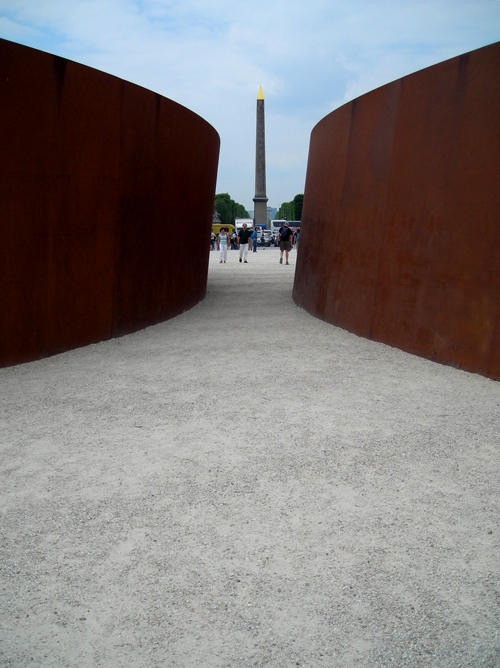day 54

after such a lovely experience yesterday, we decided to see richard serra's counterpoint to promenade – an older work called clara-clara that was made in 1983 and is installed in the tuileries gardens. I’ve written a bit about it in the comments section…
4 Comments:
seeing clara-clara was a very different experience to yesterday’s promenade – set outside, the work was quite different – but some of the similarities were equally captivating: serra's use of axis - the arch de triomphe, then place de la concorde (seen here) and museé du louvre – the shifting perspective with slanting vertical walls, the massive steel structures and the fact that the work cannot be seen from only one view point forcing the spectator to walk through and around.
simon wrote yesterday about serra’s almost dismissal of his chosen medium steel as not part of the concept: the work would be very different in paper or wood or anything else. I suspect serra’s made those comments because he has worked with heaviness for so long, knows the substance intimately and so ceases to think about it. much like virtuosity for a mover. but for someone like me who rarely looks at steel sculptures, the power, and my sense of diminished size is both overwhelming and welcomes meditation - so the medium is quite perfect for these works. they are really big. and really heavy and do very little to compliment their surroundings but rather make you look at the surroundings differently and with a keener eye. or at least that’s what I did.
but has clara-clara, made in 1983, dated compared to the work we saw yesterday? there are 30 years between these two works and it seems to be the question hovering in my mind. as an audience member not literate in sculptural fashion, I think not. the large metal sculptural objects do seem to hold traces of past decades, but for me, yesterday’s experience was profound, relevant and contemporary. what if I hadn’t heard the audio tracks telling me about the work, the space that was left for the audience and the concepts of the work? I don’t know. but the thing is I did hear them. and both artist and curators were very clear that sound would be part of the work.
I’m new to serra’s work and he’s clearly been making work along these themes for over 30 years so it would be interesting to hear from someone who actually knows about him…
We have one Serra in the National Gallery, a work called "Prop", a sheet of lead held up by a prop of rolled lead. The comments below come from a book written about our collection.
Richard Serra first began working with lead in 1968 by 'tearing' successive narrow strips from the edges of a sheet of lead laid on the floor. He made his first lead 'casting' by splashing molten lead into the junction of a floor and a wall, and his first lead 'rolls' by tightly rolling thin lead sheets into long poles. 'I wrote down a list of transitive verbs', Serra said, 'to split, to splash, to spread, to roll, to heap … and applied the infinitives.1 The first work which he made from a conjunction of these processes was Prop. 'The series of lead rolls was made from lead sheets', Serra recalled. 'I realised that I was making one form, the lead roll, and I wanted to combine it with the other form which was the sheet. It occurred to me that the roll could be used as a pole and the sheets could be propped from and off the wall without utilising a joint.2
The first Prop — the prototype of the work in the Australian National Gallery's collection — was made by Serra for his solo exhibition at the Rolf Ricke Gallery in Cologne in October 1968.3 A few months later, in December 1968, Serra made the Canberra Prop for the exhibition 'Nine at Castelli' at the Castelli Warehouse, New York, adopting slightly larger dimensions for the lead sheet and using lead alloyed with a small percentage of antimony to give the lead greater rigidity.4 Serra continued to reconstruct the work and make multiple variations on the theme of the prop for a number of exhibitions in 1969.5 All these pieces explore the effects of propping massive forms together purely by weight and gravitational pull.
I don't particularly like minimalist work but that is a personal opinion.
Beverly
I've been loving Serra's work since the early 90's. Loving - hmmm.... perhaps I'd better say that my first exposure, like with "prop" was with the smaller, more intimate pieces. Lead was used explicitly because of the way it makes you think about weight, and the forces at work, and, unusually for sculpture, feel gravity at work.
Then, in Santa Fe and elsewhere I came across the rolled steel pieces and it blew me away. The curves and the transitions clearly drag you in, but I love you point Clare about how it makes you reflect on what's around, the axes surrounding it. It makes me immediately think of the whole movement of environmental/landscape art - the link to James Turell and his light art - all about boundaries changing the perception of normal spaces/things.
We're lucky in NY in that at the Dia Beacon museum there's a room full of Serra's torqued elipses and MOMA had a huge show not too long ago as well (I can only imagine the logistics of getting 6 of them up onto the 2nd floor)
further to this conversation, I met an artist yesterday
who told me that clara-clara was set up in the park near their studios and after seven years the locals asked the council to remove it as it cut out the view of all the trees in their park.
Post a Comment
Links to this post:
Create a Link
<< Home